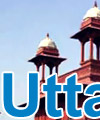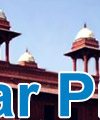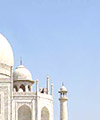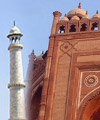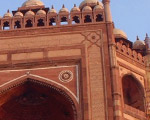|
Mathura
The city of Mathura, in Uttar Pradesh, the nucleus of Brajbhoomi,
is located at a distance of 145 km south-east of Delhi and 58 km north-west
of Agra. Covering an area of about 3,800 sq. km., today, Brajbhoomi
can be divided into two distinct units - the eastern part in the trans-Yamuna
tract with places like Gokul, Mahavan, Baldeo, Mat and Bajna and the
western side of the Yamuna covering the Mathura region that encompasses
Vrindavan, Govardhan, Kusum Sarovar, Barsana and Nandgaon.
The land of Braj starts from Kotban near Hodel about 95 km from
Delhi and ends at Runakuta which is known specially for its association
with the poet Surdas, an ardent Krishna devotee. A long line of
picturesque ghats - with their steps leading to the water's edge,
arched gateways and temple spires extending along the right bank
of the River Yamuna, emphasise the sacred character of the town
of Mathura. The birth place of Lord Krishna, "the best known,
best loved and most complex of Lord Vishnu's manifestations"
- Mathura is today an important place of pilgrimage.
Excursion
Radharamana Temple
This is the famous temple of Gopala Bhatta Gosvami. Radharamana
means "one who gives pleasure to Radha", and is one of
the many names of Lord Krishna. The seva puja of Radharamana was
established in 1542, after the Deity self-manifested from a saligram-sila.
Also kept iin this temple is the wooden sitting place (hoki) and
shawl (chaddar) or Lord Chaitanya, that He gave as a gift to Gopala
Bhatta Gosvami. There is no deity of Radharani in this temple, but
a crown is kept next to Krishna signifying Her presence.
Jugal Kisore Temple
This is one of the oldest temple of Vrindavana and was completed
in 1627. After Emperor Akbar's visit to Vridavana in the year 1570,
he gave permission for four temples to be built by the Gaudya Vaisnavas,
which were Madana-mohana, Govindaji, Gopinatha and Jugal Kisore.
It is sometimes called the Kesi ghata temple, as it is located next
to this ghata.
Kesi
Ghata
This is the place where Lord Krishna killed the Kesi demon who appeared
in the form of a gigantic horse and then took His bath in this very
same ghata. This is also very famous bathing place in Vrindavana.
An arati to Yamuna Devi is held here every evening.
Rangji Temple
This South Indian style temple was built by the wealthy Seth family
of Mathura in the year 1851, and is dedicated to Lord Sri Ranganatha
or Rangaji - a form of Lord Vishnu lying down on the Sesa Naga (celestial
serpent). This temple has a traditional South Indian gopuram (gateway)
and is surrounded by high walls. It is one of Vrindavana's largest
temples. Once a year a grand car festival (Ratha Yatra) is held
known as Brahmotsava, during the month of Chait (March - April),
this festival lasts for 10 days.
Dwarkadish Temple
The Dwarkadish Temple, built in 1814, is a popular temple in the
center of town. This is the most visited temple in the center of
town. This is the most visited temple in Mathura. This temple is
managed by followers of Vallabhacarya. Once you enter this temple
from the street, it is fairly interesting architechually and there
is a lot of activity inside. It is located in the eastern part of
Mathura, not far from the Yamuna River.
Gokul
16 km. The town where infant Krishna was brought up in secrecy and
home of his foster mother. Yashoda Maiya. The most important temple
is Gokul Nathji. Gokul is particularly known for the festivals of
Janmashtami. Annakut and Trinvat Mela, which are celebrated here
in a distinct style.
Nandgaon
56 km from Mathura. Home of Lord Krishna's foster father. Nand.
Important sites of the town are a temple devoted to Nand or Pan
Sarovar. one of the four celebrated lakes of Braj Bhoomi, where,
according to legend, Lord Krishna used to water his herd.
Jama
Masjid
Built by Nabir Khan in 1661 A.D., the Mosque has four lofty minarets,
with brightly colored plaster mosaic of which a few panels currently
exist.
Vishram Ghat
This is the sacred spot where Lord Krishna is believed to have rested
after slaying the tyrant Kansa.
Dwarkadheesh Temple
Built in 1814, it is the main temple of the town. The best time
to visit the temple is during the festive days of Holi, Janmashtami
and Diwali as it is grandly decorated.
Archaeological Museum
Located at Dampier Park, this museum has the finest collection of
rare items from the Gupta and Kushan period (400 BC to 1200AD).
Mansarovar
The rare wetland grove and bird sanctuary, roughly five acres in
size, is located a few miles across the Yamuna River. Local tradition
has it that the lake, or 'sarovar', was formed from the tears of
Sri Radha, while in an intensely emotional state of wounded love.
She came here alone when she feared she had lost Krishna. In her
memory a solitary image of her is worshipped in a small shrine beside
the lake.
Govardhan
Hill
Govardhan Hill was about 16 miles (29 km) high 5,000 years ago.
Govardhana is formed in the shape of a peacock. Radha Kunda and
Syama Kunda are the eyes. Dan Ghati is its long neck. Mukharavinda
is the mouth and Punchari is its back and tail feathers. A peacock
often curves its neck and puts his head under its stomach. Govardhana
Hill is shaped in this pose of a peacock. It is believed that the
hill is sinking by the height of a mustard seed daily as it was
cursed by Pulastya Muni.
Kusuma Sarovara
Kusuma Sarovara is a 25 minutes walk from Radha Kunda. Kusuma means
"flower," and here the gopis would pick flowers for Krishna.
Kusuma Sarovara is the best swimming spot in Mathura.
Holy Tirthas
There are 25 holy tirthas (bathing places or ghatas) in Mathura.
Visram Ghata is in the middle and there are 12 ghatas south of Visrama
Ghata and 12 ghatas north. The 12 ghatas in the south extend to
Moksa Ghata.
These holy tirthas are mostly located about 400m south of Visrama
Ghata, almost right next to each other. Many of the ghatas are known
now by different names. Asi Ghata, Prayaga Ghata, Chakra Tirtha
Ghata, Krishna Ganga, Dhruva Ghata and Visrama Ghata are still known
by the same names.
Top
Getting There
By Air
The nearest airport is Agra, at a distance of 47 km. There are regular
flights from Agra to several cities of India, including Delhi, Khajuraho
and Varanasi.
By Rail
The Mathura has its own railway station. Mathura is well connected
by train with Agra (1 hour), Bharatpur, Sawai Madhopur and Kota.
The Taj Express runs daily between Mathura and Delhi (2½
hours). Mathura is an important railway junction with direct trains
to many places.
By Road
Mathura is very well connected by a network of roads and road transport
to all major towns of Uttar Pradesh and surrounding areas. Mathura
is 141 km south of Delhi and 47 km northwest of Agra.
touristplacesinindia can arrange for you all types of land transport
for your comfortable journey in Mathura and throughout the Indian
state of Uttar Pradesh.
Top
General Information & Accomdation info on Mathura city of Uttar
Pradesh - India
|
